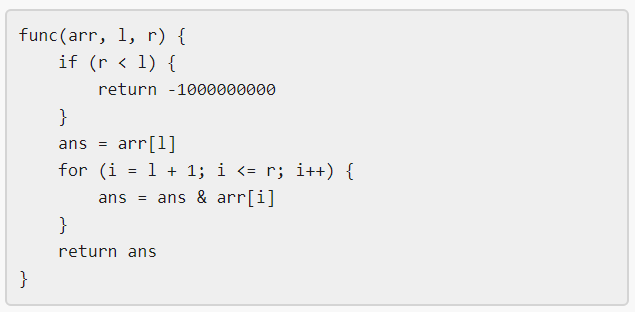| comments | difficulty | edit_url | rating | source | tags | ||||
|---|---|---|---|---|---|---|---|---|---|
true |
Hard |
2383 |
Weekly Contest 198 Q4 |
|
Winston was given the above mysterious function func. He has an integer array arr and an integer target and he wants to find the values l and r that make the value |func(arr, l, r) - target| minimum possible.
Return the minimum possible value of |func(arr, l, r) - target|.
Notice that func should be called with the values l and r where 0 <= l, r < arr.length.
Example 1:
Input: arr = [9,12,3,7,15], target = 5 Output: 2 Explanation: Calling func with all the pairs of [l,r] = [[0,0],[1,1],[2,2],[3,3],[4,4],[0,1],[1,2],[2,3],[3,4],[0,2],[1,3],[2,4],[0,3],[1,4],[0,4]], Winston got the following results [9,12,3,7,15,8,0,3,7,0,0,3,0,0,0]. The value closest to 5 is 7 and 3, thus the minimum difference is 2.
Example 2:
Input: arr = [1000000,1000000,1000000], target = 1 Output: 999999 Explanation: Winston called the func with all possible values of [l,r] and he always got 1000000, thus the min difference is 999999.
Example 3:
Input: arr = [1,2,4,8,16], target = 0 Output: 0
Constraints:
1 <= arr.length <= 1051 <= arr[i] <= 1060 <= target <= 107
According to the problem description, we know that the function
$arr[l] & arr[l + 1] & \cdots & arr[r]$
If we fix the right endpoint
$arr[l] & arr[l + 1] & \cdots & arr[r]$
The time complexity is
Similar problems:
class Solution:
def closestToTarget(self, arr: List[int], target: int) -> int:
ans = abs(arr[0] - target)
s = {arr[0]}
for x in arr:
s = {x & y for y in s} | {x}
ans = min(ans, min(abs(y - target) for y in s))
return ansclass Solution {
public int closestToTarget(int[] arr, int target) {
int ans = Math.abs(arr[0] - target);
Set<Integer> pre = new HashSet<>();
pre.add(arr[0]);
for (int x : arr) {
Set<Integer> cur = new HashSet<>();
for (int y : pre) {
cur.add(x & y);
}
cur.add(x);
for (int y : cur) {
ans = Math.min(ans, Math.abs(y - target));
}
pre = cur;
}
return ans;
}
}class Solution {
public:
int closestToTarget(vector<int>& arr, int target) {
int ans = abs(arr[0] - target);
unordered_set<int> pre;
pre.insert(arr[0]);
for (int x : arr) {
unordered_set<int> cur;
cur.insert(x);
for (int y : pre) {
cur.insert(x & y);
}
for (int y : cur) {
ans = min(ans, abs(y - target));
}
pre = move(cur);
}
return ans;
}
};func closestToTarget(arr []int, target int) int {
ans := abs(arr[0] - target)
pre := map[int]bool{arr[0]: true}
for _, x := range arr {
cur := map[int]bool{x: true}
for y := range pre {
cur[x&y] = true
}
for y := range cur {
ans = min(ans, abs(y-target))
}
pre = cur
}
return ans
}
func abs(x int) int {
if x < 0 {
return -x
}
return x
}function closestToTarget(arr: number[], target: number): number {
let ans = Math.abs(arr[0] - target);
let pre = new Set<number>();
pre.add(arr[0]);
for (const x of arr) {
const cur = new Set<number>();
cur.add(x);
for (const y of pre) {
cur.add(x & y);
}
for (const y of cur) {
ans = Math.min(ans, Math.abs(y - target));
}
pre = cur;
}
return ans;
}